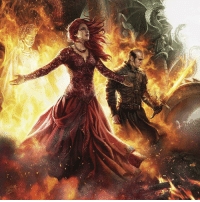What are the papillary muscles of the heart?
 The papillary muscles (papillary) are an extension of the inner layer of the heart muscle, which protrudes into the cavity of the ventricles, and, with the help of chords attached to the apex, provides a unidirectional blood flow through the chambers.
The papillary muscles (papillary) are an extension of the inner layer of the heart muscle, which protrudes into the cavity of the ventricles, and, with the help of chords attached to the apex, provides a unidirectional blood flow through the chambers.
Anatomical classification of the papillary muscles (CM):
- Right ventricle:
- Front.
- Back.
- Partition room.
- Left ventricle:
- Front.
- Back.
The names of the muscles correspond to the valve cusps to which they are attached using chords (thin tendon filaments).
The scheme of papillary muscles for each person is individual:
- common base and several tops;
- 1 base and ends with 1 top;
- several bases, which in the apical part merge into 1 apex.
Therefore, there are three types of CM:
- one-;
- two-;
- tricapillary muscles.
The shape of the papillary muscles also varies:
- cylindrical;
- conical;
- a tetrahedral pyramid with a truncated top.
The total number of papillary muscles in each individual also fluctuates (from 2 to 6), so several CMs can hold the valve leaf at once.
The number of elements is related to the width of the heart (the narrower, the fewer papillary muscles, and vice versa).
The height of the muscles directly depends on the length of the chamber cavity. The thickness of the CM ranges from 0.75 to 2.6 cm in the left ventricle, and 0.85-2.9 cm in the right. These two indicators are in inversely proportional relationship (the longer the muscle, the narrower it is, and vice versa). The length of the papillary muscles in men is 1-5 mm longer than in women.
Main functions
The ultimate goal of the papillary muscles is to provide unidirectional blood flow from the atrium to the ventricle.
During ventricular systole, the CMs contract synchronously with the myocardium and regulate the tension of the tendon chords attached to the edges of the atrioventricular valves. They pull the valves over themselves, preventing blood from returning to the inside of the atria during systole. Thus, with the help of the papillary muscles, a sufficient pressure gradient is created on the pulmonary and aortic valves.
At the initial stage of ventricular systole, the semilunar (aortic and pulmonary) valves are still closed, and the blood is directed back to the atria along the path of least resistance. But this is prevented by the contraction of the papillary muscles and the rapid closure of the valve cusps. For some time, closed cavities of the ventricles are created, which are necessary to generate sufficient pressure to open the semilunar valves.
The papillary muscles ensure the correct functioning of the heart valve system. CMs are not attached to the aortic and pulmonary valve cusps, since no sharp pressure gradient is required for their passive closure.
The valves of the atrioventricular joints are more massive and require fast and strong back pressure to close effectively within a few milliseconds.
Pathology
Pathological changes in the papillary muscles can occur both primarily and as a result of diseases of other parts of the heart.
Primary lesion of SM in the form of hypoplasia or aplasia occurs when:
- congenital mitral regurgitation;
- trisomy-18 syndrome (Edwards);
- Ebstein's anomalies - the formation of valves from the muscle tissue of the ventricles.
Congenital malformations of the mitral valve (MK), which are the basis for a defect in the papillary muscles:
- Additional MK - there is an additional element with atypical fastening.
- Arcade mitral valve - CM have an abnormal structure, often fused into one and hypertrophied.
- Additional valves (three-, four-leafed MK) - additional groups of papillary muscles are found.
- Parachute MK - an enlarged papillary muscle is detected on the echocardiography, which simultaneously “connects” two valves of the MK.
In all of the above cases, defective papillary muscles exacerbate the clinical manifestations of valvular insufficiency.
SM tissues can be affected by a tumor process (most often - lymphoma). Also, papillary muscles are often damaged due to infectious diseases (endocarditis, rheumatism).
After the transferred ulcerative variant of infective endocarditis, adhesion of adjacent papillary muscles with each other with the formation of a valve defect with a predominance of insufficiency is observed.
Changes in papillary muscles with tricuspid valve defects:
- dullness of the tops of the CM (especially the front ones);
- fusion of the anterior papillary muscles with the marginal zone of the tricuspid valve cusps;
- marginal fusion of the SM with the wall of the right ventricle.
Changes in the structure of the papillary muscles with acquired stenosis of the mitral valve:
- thickening and lengthening of the CM;
- accretion of papillary muscles into a single conglomerate;
- soldering the edges of the CM to the surface of the left ventricle;
- the tops of the muscles are soldered to the cusps of the mitral valve.
An increase in the size of the CM is observed in hypertrophic cardiomyopathy, since the papillary muscles are a continuation of the inner layer of the ventricular myocardium. The enlarged CM reduces the useful volume of the left sections, which reduces the ejection fraction and aggravates hemodynamic disorders.
In the last 70 years, the term "cirrhotic cardiomyopathy" has appeared - a change in the structure and functioning of the myocardium due to metabolic and hemodynamic disorders caused by liver cirrhosis. Violation of the contractile function of the papillary muscles in such patients leads to the formation of mitral and tricuspid insufficiency with intact (intact) valve tissue.
Ruptured papillary muscles
Rupture of the papillary muscle is a serious condition caused by injury or myocardial infarction with the subsequent "dissolution" of fibers. This complication becomes the cause of death of the patient in 5% of cases.
More often, the posterior papillary muscle undergoes necrosis, which is explained by the poorer blood supply in comparison with the anterior one.
Due to the rupture of the CM during ventricular systole, one of the leaflets of the mitral valve (MV) falls into the left atrial cavity. MV failure promotes the movement of blood in the opposite direction, which causes severe failure. Violation of the outflow of fluid leads to an increase in pressure in the pulmonary veins (cardiogenic edema) and a drop in systemic hemodynamic parameters.
The main symptoms and paraclinical signs of rupture are:
- sudden onset - chest pain, heart palpitations, severe shortness of breath, frothy sputum;
- auscultation: soft murmur in the IV intercostal space on the left, intensifying during systole and carried out in the axillary region;
- weakening of the I tone at the apex of the heart;
- EchoCG - M-shaped flapping mitral valve leaflet, which, when the ventricles contract, opens into the atrial cavity;
- Doppler sonography - regurgitation of varying degrees with turbulent blood flow.
Treatment of papillary muscle ruptures is exclusively surgical, after preliminary drug stabilization of indicators. The essence of the intervention is the setting of an artificial MC or the removal of a part of the valve with plastics of the atrioventricular opening. Early mortality reaches 50% after urgent cardiac surgery.
Also, with Q-myocardial infarction, most patients by the end of the first week develop SM dysfunction due to ischemia and remodeling (restructuring) of the muscle "frame". This condition does not require surgical treatment, the symptoms diminish against the background of intensive therapy for a heart attack.
Conclusions
Complete rupture of the papillary muscle is accompanied by a high risk of death within 24 hours. A tear of the CM or damage to one of several heads leads to less pronounced mitral regurgitation with the possibility of emergency intervention and correction of the condition. Acute myocardial infarction is a dangerous pathology that threatens the patient's life even after the restoration of the basic function of the heart. The need for long-term follow-up in a cardiac center is dictated by the risk of early complications, including rupture of papillary muscles.



